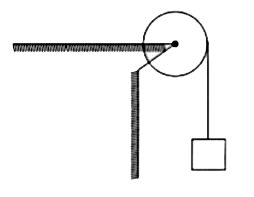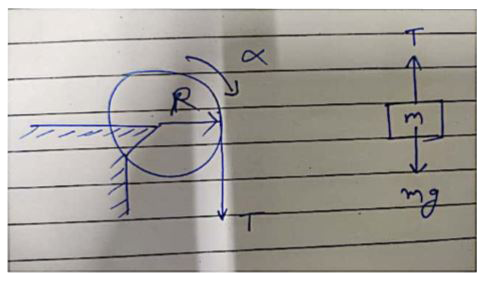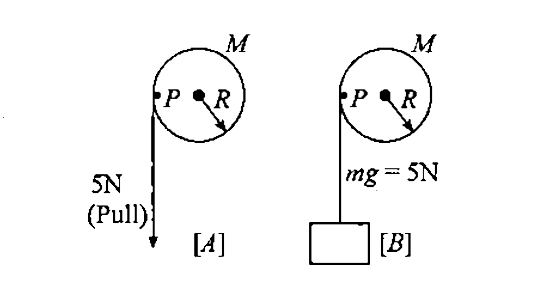The figure shows a uniform disc, with mass M = 2.4 kg and radius R= 20 cm, mounted on a fixed horizontal axle. A block of mass m = 1.2 kg hangs from a massless cord that is wrapped around the rim of the disc. The tension in the cord is

12 N
20 N
24 N
none of these
The correct Answer is:D

From figure acceleration of block
mg – T = ma
T=m(g−a)
for unwrapping a=αR
torque of dics is ζ=αR
ζ=RT=Idiscα
α=RTIdics where, Idisc=MR22
α=2Tm
from equation 1st
T=m(g−1)
after solving this we get
T=6N
Topper's Solved these Questions
Similar Questions
Figure shows a uniform disk, with mass M=2.4kg and radius R=20 m, mounted on a fixed horizontal axle. A block of mass m=1.2 kg hangs from a massless cord that is wrapped around the rim of the disk. The tension (in newton) in cord. Is
'(##CEN_KSR_PHY_JEE_C09_E01_019_Q09##)'
View SolutionFigure shows a uniform disk, with mass M = 2.5 kg and radius R = 20 cm, mounted on a fixed horizontal axle. A block with mass m = 1.2 kg hangs from a massless cord that is wrapped around the rim of the disk. Find the acceleration of the falling block, the angular acceleration of the disk, and the tension in the cord. The cord does not slip, and there is no friction at the axle.
View Solution
Knowledge Check
A uniform disc of mass M and radius R is mounted on a fixed horizontal axis. A block of mass m hangs from a massless string that is wrapped around the rim of the disc. The magnitude of the acceleration of the falling block (m) is
A2MM+2mgB2mM+2mgCM+2m2MgD2M+m2MgA uniform disc of mass 2 kg and radius 1m is mounted on an axle supported on fixed frictionless bearings. A light chord is wrapped around the rim of the disc and mass of 1kg is tied to the free end. If it is released from rest-
Athe tension in the chord is 5NBin first four seconds the angular displacement of the disc is 40 radCthe work done by the torque on the disc in first four seconds is 200JDthe increase in the kinetic energy of the disc in the first four seconds in 200 JA uniform disc of mass M =2.50 kg and radius R=0.20 m is mounted on an axle supported on fixed frictionless bearings. A light cord wrapped around the rim is pulled with a force 5 N. On the same system of pulley and string, instead of pulling it down, a body of weight 5 N is suspended. If the first processis termed A and the second B, the tangential acceleration of point P will be:
 AEqual in the processes A and B.BGreaterin process A than in B.CGreater in process Bthan in 4.DIndependent of the two processes.
AEqual in the processes A and B.BGreaterin process A than in B.CGreater in process Bthan in 4.DIndependent of the two processes.
A uniform disc of mass M and radius R is mounted on a fixed horizontal axis. A block of mass m hangs from a massless string that is wrapped around the rim of the disc. The magnitude of the acceleration of the falling block (m) is
View SolutionA disc shaped pulley of mass 'm'=4kg and radius R=0.5m can rotate freely about its center. A block of mass M=2kg hangs from the pulley through is massless string that is tightly wrapped around the pulley. When the system is released, there is no slipping between pulley and string.

(a) Calculate the angular accelerating of the pulley
(b) Calculate the tension in the string
View SolutionA disc shaped pulley of mass 'm'=4kg and radius R=0.5m can rotate freely about its center. A block of mass M=2kg hangs from the pulley through is massless string that is tightly wrapped around the pulley. When the system is released, there is no slipping between pulley and string.

(a) Calculate the angular accelerating of the pulley
(b) Calculate the tension in the string
View SolutionFig. shows a uniform disc of mass 1 kg and radius 0.2 m mounted on an axle supported in fixed frictionless bearings. A light string is wrapped around the rim of the wheel. A constant downwards pull of 2 kg wt. is exerted on the string. What is the angular acceleration of the wheel and the tangential acceleration of a point on the rim ?

View SolutionA uniform disc of mass M =2.50 kg and radius R=0.20 m is mounted on an axle supported on fixed frictionless bearings. A light cord wrapped around the rim is pulled with a force 5 N. On the same system of pulley and string, instead of pulling it down, a body of weight 5 N is suspended. If the first processis termed A and the second B, the tangential acceleration of point P will be:

View Solution
